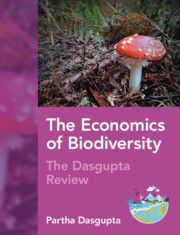Book contents
- The Economics of Biodiversity
- The Economics of Biodiversity
- Copyright page
- Contents
- List of Boxes
- Foreword
- Preface to the CUP Edition
- Preface
- Part I Foundations
- Chapter 0 How We Got to Where We Are
- Chapter 1 Nature as an Asset
- Chapter 2 Biodiversity and Ecosystem Services
- Chapter 3 Biospheric Disruptions
- Chapter 4 Human Impact on the Biosphere
- Chapter 4* The Bounded Global Economy
- Chapter 5 Risk and Uncertainty
- Chapter 6 Laws and Norms as Social Institutions
- Chapter 7 Human Institutions and Ecological Systems, 1: Unidirectional Externalities and Regulatory Policies
- Chapter 8 Human Institutions and Ecological Systems, 2:
- Chapter 8* Management of CPRs:
- Chapter 9 Human Institutions and Ecological Systems, 3:
- Chapter 10 Well-Being Across the Generations
- Chapter 11 The Content of Well-Being: Empirics
- Chapter 12 Valuing Biodiversity
- Chapter 13 Sustainability Assessment and Policy Analysis
- Chapter 13* Accounting Prices and Inclusive Wealth
- Part II Extensions
- Part III The Road Ahead
- Appendix
- Acronyms
- Glossary
- References
- Acknowledgements
- Author Index
- Subject Index
Chapter 12 - Valuing Biodiversity
from Part I - Foundations
Published online by Cambridge University Press: 10 March 2025
- The Economics of Biodiversity
- The Economics of Biodiversity
- Copyright page
- Contents
- List of Boxes
- Foreword
- Preface to the CUP Edition
- Preface
- Part I Foundations
- Chapter 0 How We Got to Where We Are
- Chapter 1 Nature as an Asset
- Chapter 2 Biodiversity and Ecosystem Services
- Chapter 3 Biospheric Disruptions
- Chapter 4 Human Impact on the Biosphere
- Chapter 4* The Bounded Global Economy
- Chapter 5 Risk and Uncertainty
- Chapter 6 Laws and Norms as Social Institutions
- Chapter 7 Human Institutions and Ecological Systems, 1: Unidirectional Externalities and Regulatory Policies
- Chapter 8 Human Institutions and Ecological Systems, 2:
- Chapter 8* Management of CPRs:
- Chapter 9 Human Institutions and Ecological Systems, 3:
- Chapter 10 Well-Being Across the Generations
- Chapter 11 The Content of Well-Being: Empirics
- Chapter 12 Valuing Biodiversity
- Chapter 13 Sustainability Assessment and Policy Analysis
- Chapter 13* Accounting Prices and Inclusive Wealth
- Part II Extensions
- Part III The Road Ahead
- Appendix
- Acronyms
- Glossary
- References
- Acknowledgements
- Author Index
- Subject Index
Summary
Ecosystems are capital goods. Biodiversity is a characteristic of ecosystems. In the terminology introduced in Chapter 1, it is an enabling asset.389 Biodiversity loss is not the same as environmental pollution. Air pollution would be bad even if it did not emanate from activities that harm biodiversity; we dislike pollution if only because it is bad for human health. In contrast to biodiversity, pollutants are a form of capital stock (but with a negative accounting price; Chapter 2).
In Chapter 2, we studied the sense in which ecosystems that are rich in biodiversity are productive. So one can argue that biodiversity’s value is derived from the productivity it confers on ecosystems. Against that is the view that biodiversity also has a value independent of its effects on the biosphere’s ability to produce goods and services for us.
- Type
- Chapter
- Information
- The Economics of BiodiversityThe Dasgupta Review, pp. 305 - 326Publisher: Cambridge University PressPrint publication year: 2024

